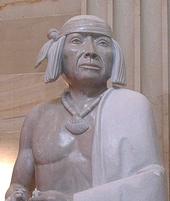Hopi elder, Radford Quamahongnewa, shares the Hopi Way in the Hopi language. Po'pay and the success of the Pueblo Revolt of 1680 are credited with preserving the Hopi Way of life.
Radford shares the Hopi Way in the English language
About Po'pay
In 1675 Po’pay and 46 other Pueblo leaders were convicted of sorcery; he was among those flogged, while others were executed. In 1680 Po’pay organized the Pueblo Revolt against the Spanish. According to oral history, to coordinate the timing of the uprising, he and his followers sent runners to each pueblo with knotted deerskin strips. One knot was to be untied each day, and the revolt would begin on the day the last one was untied. However, the Spaniards arrested two of the runners, and the pueblos were quickly notified to accelerate the revolt. The attacks began on August 10, two days before the last knot would have been untied. The Spaniards took refuge at Santa Fe; the besieging Indians cut off their water supply but soon permitted them to leave the area. Although the Spanish returned 12 years later, the King of Spain recognized Pueblo sovereignty and set aside land grants for the tribes. These land grants kept the Pueblo people on their ancestral land.
The Pueblo Revolt helped to ensure the survival of the Pueblo traditions, language and religion, restoring a respect for life, harmony, peace and freedom. What makes this achievement even more impressive is the fact that the Pueblos are not one unified group; rather they are separate nations. They share a common traditional native religion, lifestyle and the same geographical location. However, each maintains a unique identity, exemplified in their three distinct and different language families with diverse origins. Po'pay was able to unite separate Pueblo nations into a unified force powerful enough to bring about a change so monumental as to alter the history of an entire region.
In 1997, the New Mexico Legislature selected Po’pay as the subject of the state’s second statue for the National Statuary Hall Collection and created the New Mexico Statuary Hall Commission, whose members were appointed by Governor Gary Johnson. Four sculptors were selected to create maquettes, and Cliff Fragua from Jemez Pueblo was awarded the commission in December 1999. It is now the seventh statue of a Native American in the collection; the others are King Kamehameha I, Will Rogers (who had Cherokee ancestors), Sakagawea, Sequoyah, Washakie, and Sarah Winnemucca.
The seven-foot-high statue was carved from pink Tennessee marble (making it the only colored marble statue in the collection) and stands on a three-foot-high pedestal comprised of a steel frame clad in black granite. It is the final statue to be installed in the collection and the only one sculpted by a Native American. The statue was unveiled in a ceremony held at Ohkay Owingeh on May 21st, 2005, and installed in the Rotunda of the U.S. Capitol on September 22nd later that year.
Sculptor Cliff Fragua describes the statue thus: In my rendition, he holds in his hands items that will determine the future existence of the Pueblo people. The knotted cord in his left hand was used to determine when the Revolt would begin. As to how many knots were used is debatable, but I feel that it must have taken many days to plan and notify most of the Pueblos. The bear fetish in his right hand symbolizes the center of the Pueblo world, the Pueblo religion. The pot behind him symbolizes the Pueblo culture, and the deerskin he wears is a humble symbol of his status as a provider. The necklace that he wears is a constant reminder of where life began, and his clothing consists of a loin cloth and moccasins in Pueblo fashion. His hair is cut in Pueblo tradition and bound in a chongo. On his back are the scars that remain from the whipping he received for his participation and faith in the Pueblo ceremonies and religion.
2007 Promotional Short about Po'pay, titled, "In the Spirit of Po'pay"
Now viewing! A promotional film for the Po'pay Project, a series of film, television and internet projects designed to bring the story of Po'pay around the world.
